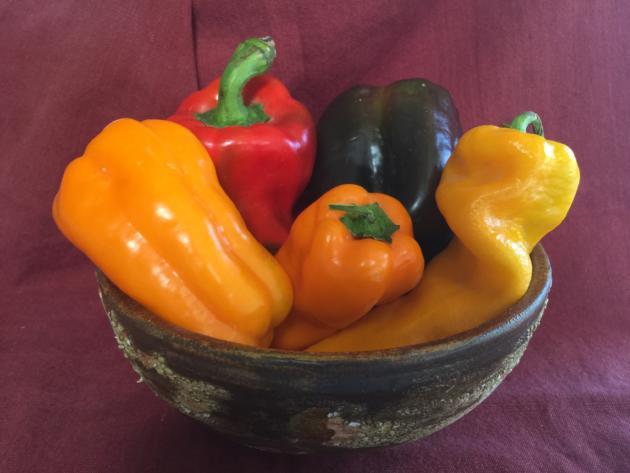
By Denise Miller / For the Journal
Published: Wednesday, September 27, 2017

Roasted peppers — both hot and sweet — are one of the most versatile foods you can have in your freezer. Keep them on hand to top scrambled eggs, grilled shrimp, poultry, pork or beef. Or toss roasted peppers into cooked grains or beans.
ALBUQUERQUE, NM — As late summer gracefully sways into early autumn, harvest time continues in New Mexico. This means local farmers are still busting their fannies to bring us the best-tasting fruits and vegetables.
Most neighborhood growers’ markets across the state continue their weekly hours through October, and right now you are likely to still find the last of summer’s best corn, melons, plums, cucumbers, beans, tomatillos, peppers and tomatoes, right alongside fall’s spectacular array of apples, pears, eggplant, cauliflower, okra, potatoes, hard squash and more.
Let the cornucopia of local food that’s available inspire your daily breakfast, lunch and dinner menus, but if you also want to make the most of peak season, be sure to preserve your favorite foods.
Save some cash
When shopping at your local growers’ market with an eye toward preserving, there are a few things you can do to try and keep costs down:
- Buy foods at the peak of their season. When you see lots of vendors with tomatoes, for example, they should be selling at the season’s most affordable price. The more regularly you shop at your growers’ market, the more tuned in you will be to seasonality and prices.
- Ask farmers if they have “seconds.” The most perfect looking crops are usually sold first, but slightly bruised apples or tomatoes will taste just as great cooked in a sauce, and growers usually sell these items for less.
- Shopping at the end of a market day often means bargains can be found.
Freeze for ease
Freezing is the most commonly used food preservation technique, and most New Mexicans are familiar with this method for storing green chile. Freezing for long-term storage requires some know-how to get the best tasting produce out of the freezer and avoiding the dreaded “freezer burn.”
Some factors to consider are ample freezer space and having a reliable electric supply. Freezing also means thinking about the containers in which you will freeze your produce.
Before freezing, fruits and vegetables need a bit of processing, such as slicing and blanching. But fruits and vegetables can be kept frozen for six to 12 months in a freezer at 0 degrees Fahrenheit, meaning you can enjoy it all before the next harvest season approaches.
There are lots of ways to make freezing work for you. For example:
- Freeze batches of single ingredients such as green beans, beets, peppers or carrots.
- Create “stock” ingredients for general cooking like chopped onions, garlic, pesto, salsa, sauce and stock.
- Cook and freeze soups, stews, casseroles or side dishes.
- Freeze single servings of healthy meals that you can grab for lunch or dinner, and control portion size.
Other methods
Dehydrating (drying) food is arguably the most efficient, and oldest, method of food preservation. It requires heating the food to eliminate moisture quickly enough that flavor is not affected, but not at a temperature that is so hot that it cooks the food. Air circulation is also paramount. Techniques can vary from solar dehydration to electric dehydrators.
Canning is a well-known method of home food preservation. It uses glass jars with pressure-sealing lids and preserves the contents using a water bath or pressure canner. Most New Mexico State University Cooperative Extension offices have home economist experts ready to help.
Candying fruits, also known as “glacé” or crystallized fruit, involves placing whole or pieces of fruit in a heated syrup then draining it, and repeating this process. It is the intense saturation of the fruit in sugar that enhances desiccation and creates an environment unfavorable for bacterial growth. Plus, it’s very tasty!
Pickling is the use of an anti-microbial brew to preserve fruits and vegetables. Typical pickling liquids include vinegar, brines, alcohol and additional ingredients to flavor the food such as salts, herbs, and spices.
Whatever your favorite method of food preservation – dehydrating, canning, pickling, candying, freezing – buying locally grown food in bulk during peak season puts a freeze on food costs and helps extend the taste of summer for months to come.
Special thanks this month to New Mexico Farmers’ Marketing Association staff member Christina Keibler for food preservation tips.
Denise Miller is executive director of the New Mexico Farmers’ Marketing Association. Visit farmersmarketsnm.org.

Tomatillo Salsa is great served over enchiladas or alongside barbecued meats.
TOMATILLO SALSA
(Makes 3 cups)
4 cups chopped tomatillos
2 cups chopped onions
¼ cup chopped sweet red peppers
1 small jalapeño pepper, minced (wear plastic gloves while handling)
1 teaspoon olive oil
¼ cup lemon juice
¼ cup chopped fresh parsley
½ teaspoon salt
In a large saucepan, combine the tomatillos, onions, red peppers, jalapeño peppers and oil. Cook, stirring. Bring to a boil over medium-high heat. Cook and stir for 10 minutes, or until reduced by half. Stir in lemon juice, parsley and salt.
To freeze, pack the cooled cooked salsa in small freezer-quality plastic containers. To use, thaw overnight in the refrigerator or briefly in the microwave.

After peppers are charred, close them into a paper bag to steam. This makes the thin tough skin easier to remove.
ROASTED PEPPERS
To roast peppers, halve them lengthwise and remove the seeds.
Place, cut side down, on a broiler pan. Broil 4 inches from the heat until blistered.
Transfer to a paper bag, close, and set aside to steam for 10-15 minutes. This makes the thin, tough skin easier to remove.
Peel off the skin and discard.
Use freezer-quality containers or freezer-quality plastic bags, and for best taste, use within six months. Thaw overnight in the refrigerator, or briefly in the microwave.
HERBED TOMATO SAUCE
(Makes 4 cups)
6 pounds tomatoes, coarsely chopped
1 teaspoon Italian herb seasoning (or combine oregano and basil)
½ teaspoon ground black pepper
¼ teaspoon salt
In a blender or food processor, combine the tomatoes, Italian herb seasoning, black pepper and salt. Process briefly to a coarse puree.
Pack in freezer-quality plastic containers or freezer-quality plastic bags. If freezing in bags, lay bags flat on cookie sheet until frozen. Then remove pan. The flat bags will save space in the freezer.
Freeze up to six months – the flavor actually improves in the freezer. Enjoy the simple sauce as is, or after it is defrosted, add garlic, wine, peppers, or any favorite ingredients.

